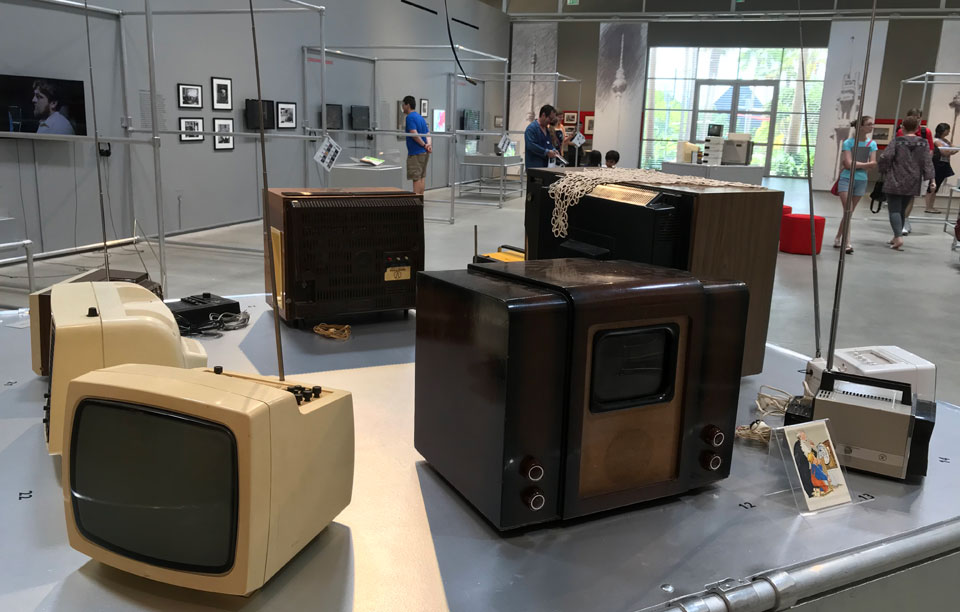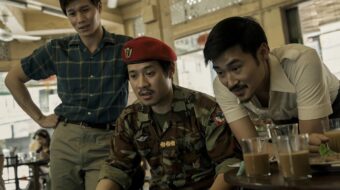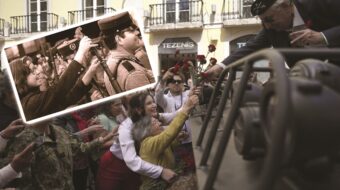
CULVER CITY, Calif.—The Wende Museum’s ingenuity in refiguring its generous open space in what was formerly the town armory building to accommodate the needs of each of its new exhibitions never fails to impress. For the current shows, they have chosen a boundless, transparent look lined on each side of their long space with bite-sized booths featuring a variety of subtopics on the theme, “Watching Socialism: The Television Revolution in Eastern Europe.” A smaller accompanying photo and video display concerns “Nonalignment and Tito in Africa.”
I remember thinking, on my forays into Eastern European socialism in the 1970s and ’80s, that politics aside, most people’s lives ambled along pretty uneventfully as they went about their daily routines of work, family, school, and recreation. The Wende exhibition confirms this impression. In the GDR and Czechoslovakia, I remember television as a standard part of the environment in restaurants and bars, although I did not have the opportunity visit many people’s private homes. In the Ukrainian SSR I had one particularly memorable encounter with television:
At one of my tour group’s meetings with the Soviet Peace Committee branches in the five cities we visited in 1980, I met a young reporter from Radio Kiev who invited me to his flat after our formal exchange of ideas. He was eager to improve his English, and I was interested in seeing what his home life was like. On the way we purchased chocolate candies and a bottle of wine, which we dove into waiting for his wife and little baby to return home from a check-up at the clinic.
I questioned him about editorial policy at Radio Kiev. He had to submit to his producer a full transcript of everything he had prepared for broadcast. In case of some statement of mine which could be construed as critical of Soviet policy, yes, it would be aired, but at that point in the tape he would have to insert his own explanation for my misstatement or misinterpretation.

The evening news came on the television, opening with a feature on a steel worker who won the “Hero of Socialist Labor” award. Then came a story about the Soviet furniture industry which took us from the timber forests to the finishing plant. Other items had to do with visiting ambassadors, trade missions, and an international round-up whose main report concerned the testimony of Black South Africans at an international tribune against apartheid.
There were two agricultural stories, one about the abundant grain crop that year, presumably meant to reassure viewers that the U.S. embargo (over the issue of Afghanistan) had exerted no appreciable impact. The second story immediately struck me as having a different tone entirely: The head of a collective farm was interviewed standing before a row of tractors. Defective workmanship and the lack of spare parts had caused these new machines to be inoperable. Thus the farm had to get along on its old ones, with predictably slower yields. My host assured me that as of tomorrow morning that collective farm would have all the perfectly functioning tractors it needed. As in the West, in the USSR, too, the Fourth Estate often exerted an effective checks-and-balances role.
A quick glance at the Wende interior suggests the spareness of this particular exhibition, but a closer look belies that first impression. Many of the wall-less “booths” are actually viewing stations with headphones, and at any given spot you may encounter up to a dozen separate videos drawn from Eastern European socialist television.
These clips are educational, news, game shows, talent shows, and cartoons, not so dissimilar to what Western audiences saw at the same time, though certainly less flashy. By no means did all the content reflect the current party line, as social leaders came to realize that consumers wanted their entertainment without thick layers of propaganda. Programming for children’s consumption emphasized themes of sharing and kindness, not socialism as such.
If a visitor wanted to watch every single item available, it would take a binge session of several hours to get through it all.
If television was a means of communicating the overall values of the dominant system—same purpose as in the West—it also in the long run challenged the system by exposing viewers to ideas broadcast from social systems outside the Soviet Bloc. Viewers in the GDR could watch West German and Swedish TV; Soviet viewers in Estonia could receive Finnish TV; Italian TV reached Yugoslavia. The reverse transmission route was true as well.

The museum also has scores of excellently mounted still photographs showing the way televisions were integrated into home décor, how TV shows were staged, how newscasters dressed, how TV appliances were marketed, sold, and repaired. Display tables show a generous selection of TV sets manufactured in different countries as part of the material culture of Eastern Europe for which the Wende Museum of the Cold War is renowned, and puppets, board games, maquettes, and ceramic pieces related to television culture. The (East) Berlin Television Tower, with its distinctive ball housing a restaurant near the top, became the single most prominent feature of the Berlin cityscape, and appears on several items.
In addition, the museum publishes sumptuous, collectible catalogues of its exhibitions, with reprints of all the photos and stills from many of the videos. These are also accessible on the museum’s website.
Politics are of course not omitted, though this is not the central focus. Especially interesting are televised interviews from around the time of the fall of the Berlin Wall—watch Gregor Gysi milking a cow!—and from the street protests all around Romania that led to the Christmas 1989 demise of the hated Ceausescus.
Museumgoers will find this exhibition intriguing and largely devoid of the ever so slightly triumphalist point of view I have often found discoloring the Wende’s treatment of history—i.e., pointing up all the fateful flaws in the socialist system (which cannot be denied), while neglecting to emphasize the achievements in education, culture, sports, healthcare, full employment, housing, support for the underdeveloped world, and in the search for world peace and mutual co-existence. In the east display corridor can be seen a small separate new grouping of Cuban posters in solidarity with Africa, which is a little off the Wende’s beaten track, but well worth checking out.
Josip Broz Tito, the Nonaligned Movement and Africa
The needle bends more in the direction of overt support for the ideals of socialism and internationalism in this smaller collection of photos and videos of the Yugoslav leader’s many trips to Africa that accompanies the larger television exhibition. This collection comes to the Wende courtesy of the Museum of Yugoslavia in Belgrade, Serbia. Readers know, of course, that Yugoslavia no longer exists as a country. Instead it has broken up into half a dozen separate nations that correspond to the former republics within the larger entity of Yugoslavia. (First Lady Melania Trump grew up in one of those Yugoslav republics, the now independent Slovenia.) Similarly, the USSR itself dissolved into its constituent republics.
Among the great achievements of both these greater nations that should be better remembered today was the encouragement of a sense of common purpose in unity and the suppression (somewhat harsh at times, it must be acknowledged) of nationalist, ethnic, religious, and tribal competition and enmity. I speak for no one but myself—though I know many others share my thinking—when I say that though there was some containment of nationalist and sometimes racist patriotism that went too far for the regime and might have threatened the integrity of the larger entities (USSR and Yugoslavia), the larger benefit of ethnic harmony and economic integration far surpassed the negatives on balance.

Specifically to this point, I doubt the USSR could have resisted the Nazi hordes and won World War II had Byelorussia, Ukraine, the Baltic countries, Russia, etc., been unrelated neighboring independent states. As for Tito’s leadership of the Yugoslav partisan forces against the Nazis, this is well known; his record served all his life as the principal reason Yugoslavia was able to hold together. Absent Tito, the imperialist powers started picking away at the Yugoslav remains to weaken and disempower this force for good in the world.
This modest group of photographs emphasizes Tito’s many visits to African nations to sign agreements, visit projects created with Yugoslav aid, discuss world affairs and the part that nonaligned nations could play in the United Nations. Yugoslavia, though socialist with many market features since the time of its break with the USSR in 1948, positioned itself as a unique European outpost ideologically in-between East and West, among the leaders of the global nonaligned community.
The photos are skewed toward the Titos in Africa—in such countries as Kenya, Sudan, Guinea, Ghana, Libya, Mali, Tanzania, Egypt, and Ethiopia—while the reciprocal visits of African leaders and cultural representatives to Yugoslavia are not included. Nor are the specific projects for which Yugoslavia provided material help mentioned in any detail. The photographers perhaps revealed their own cultural biases by portraying the Europeans with their dress and demeanor as the enlightened partners to the poorer, less sophisticated Africans in a relationship of patron and patronized.
Nevertheless, for all the limitations of its epoch, it was a welcome acknowledgment on the Wende’s part, perhaps more by implication than by overt declaration, that at a time when the Western nations were trying to keep Africa in colonial dependency and post-colonial co-dependency and debt, the socialist countries were actively providing succor, relief, and development largely without strings.
As Tito declaimed to the Ghana Parliament in this newly emancipated epoch for Africa, “Millions of ordinary people have entered the stage of history. They will not allow a handful of irresponsible belligerent people to gamble with their destiny.”
The Wende Museum is located at 10808 Culver Blvd., Culver City 90230. The website provides further information on visiting hours. This double exhibition runs through October 20, 2019.












Comments